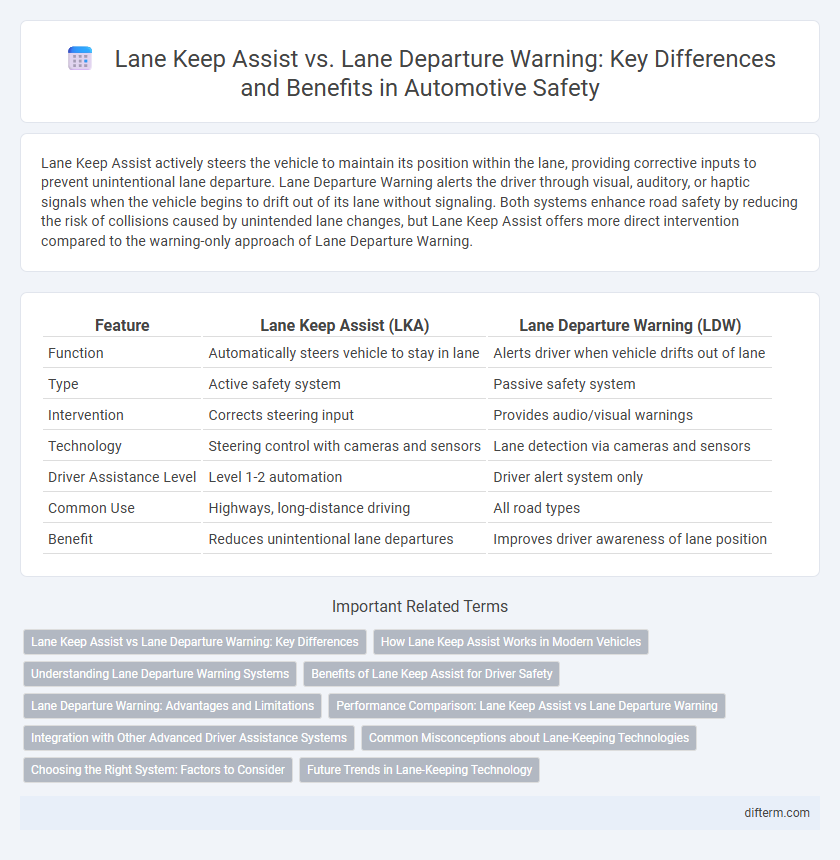Lane Keep Assist actively steers the vehicle to maintain its position within the lane, providing corrective inputs to prevent unintentional lane departure. Lane Departure Warning alerts the driver through visual, auditory, or haptic signals when the vehicle begins to drift out of its lane without signaling. Both systems enhance road safety by reducing the risk of collisions caused by unintended lane changes, but Lane Keep Assist offers more direct intervention compared to the warning-only approach of Lane Departure Warning.
Table of Comparison
| Feature | Lane Keep Assist (LKA) | Lane Departure Warning (LDW) |
|---|---|---|
| Function | Automatically steers vehicle to stay in lane | Alerts driver when vehicle drifts out of lane |
| Type | Active safety system | Passive safety system |
| Intervention | Corrects steering input | Provides audio/visual warnings |
| Technology | Steering control with cameras and sensors | Lane detection via cameras and sensors |
| Driver Assistance Level | Level 1-2 automation | Driver alert system only |
| Common Use | Highways, long-distance driving | All road types |
| Benefit | Reduces unintentional lane departures | Improves driver awareness of lane position |
Lane Keep Assist vs Lane Departure Warning: Key Differences
Lane Keep Assist actively steers the vehicle to maintain its position within the lane, whereas Lane Departure Warning only alerts the driver with visual or audible signals when unintentional lane drifting is detected. Lane Keep Assist integrates with the steering system for corrective action, enhancing safety by reducing reliance on driver reaction time. Lane Departure Warning acts as a passive system designed to increase driver awareness without direct vehicle control intervention.
How Lane Keep Assist Works in Modern Vehicles
Lane Keep Assist in modern vehicles uses cameras and sensors to continuously monitor lane markings, detecting unintended lane drift. When the system identifies the vehicle approaching a lane boundary without signaling, it actively intervenes by applying gentle steering corrections to maintain lane position. This technology enhances safety by reducing the risk of collisions caused by driver inattention or drowsiness.
Understanding Lane Departure Warning Systems
Lane Departure Warning systems use cameras and sensors to detect unintentional drifting out of a lane, alerting drivers through visual, audible, or haptic signals to prevent accidents caused by lapses in attention. These systems do not actively steer the vehicle but focus on early warning to correct the course manually. Advanced implementations integrate real-time data processing for increased accuracy in various driving conditions, emphasizing driver safety without autonomous intervention.
Benefits of Lane Keep Assist for Driver Safety
Lane Keep Assist enhances driver safety by actively preventing unintended lane departures through gentle steering corrections, reducing the risk of collisions. Unlike Lane Departure Warning, which only alerts the driver, Lane Keep Assist provides automated support, lessening driver fatigue and improving overall vehicle control. This technology is especially beneficial on highways and long drives, where maintaining lane discipline is critical for accident prevention.
Lane Departure Warning: Advantages and Limitations
Lane Departure Warning (LDW) enhances vehicle safety by alerting drivers when the car unintentionally drifts out of its lane, reducing the risk of collisions caused by distracted or fatigued driving. The system's advantages include early detection of lane deviations and minimal driver intervention, contributing to accident prevention without overriding control. However, LDW limitations involve false alerts in poor weather or unclear lane markings, and it does not actively steer the vehicle back, relying solely on driver response.
Performance Comparison: Lane Keep Assist vs Lane Departure Warning
Lane Keep Assist (LKA) actively steers the vehicle back into the lane when unintentional drifting is detected, enhancing safety by reducing collision risk. Lane Departure Warning (LDW) only alerts the driver through audio or visual signals without intervening, relying on driver response time. Performance metrics show LKA reduces lane departure incidents by up to 38%, while LDW alone achieves a 24% improvement in alerting but depends heavily on driver reaction.
Integration with Other Advanced Driver Assistance Systems
Lane Keep Assist seamlessly integrates with adaptive cruise control and blind spot monitoring to provide continuous steering correction and enhance overall vehicle stability. Lane Departure Warning primarily relies on alert systems and works in tandem with forward collision warning to prompt driver attention without direct vehicle control intervention. Both systems contribute to comprehensive driver assistance but differ in their level of active engagement with integrated safety technologies.
Common Misconceptions about Lane-Keeping Technologies
Lane Keep Assist (LKA) and Lane Departure Warning (LDW) are often confused, yet they serve distinct functions: LDW alerts drivers when drifting out of a lane without signaling, while LKA actively corrects steering to maintain lane position. A common misconception is that LKA can fully replace driver attention, but it functions as a support system requiring constant driver engagement. Understanding these differences is crucial for safe use and realistic expectations of automotive lane-keeping technologies.
Choosing the Right System: Factors to Consider
Choosing between lane keep assist and lane departure warning depends on factors such as driver preferences, vehicle type, and road conditions. Lane keep assist actively corrects steering to maintain lane position, ideal for drivers seeking automated support, while lane departure warning provides alerts without intervention, suitable for those preferring manual control. Evaluating system responsiveness, integration with other safety features, and the vehicle's technology compatibility ensures optimal selection for enhanced roadway safety.
Future Trends in Lane-Keeping Technology
Future trends in lane-keeping technology emphasize enhanced integration of lane keep assist with advanced sensors and AI-driven predictive analytics, improving vehicle positioning accuracy and reaction time. Autonomous driving systems increasingly combine lane keep assist with lane departure warning to create seamless corrective actions and alerts, reducing driver workload and enhancing safety. Continuous advancements in V2X communication and real-time environmental mapping will further refine these systems, enabling adaptive lane management in complex traffic conditions.
lane keep assist vs lane departure warning Infographic

 difterm.com
difterm.com